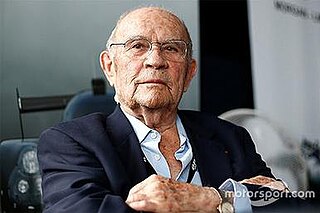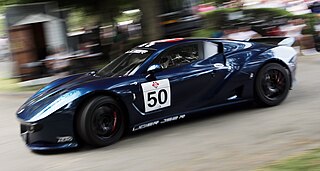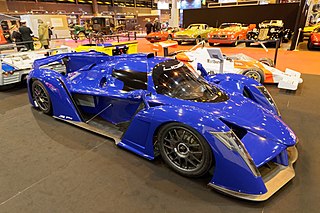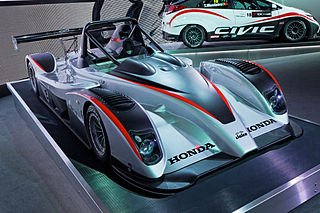
Ligier is a French automobile and minibus maker created by former racing driver and rugby player Guy Ligier (1930–2015), specialized in the manufacturing of microcars. Ligier is best known for its involvement in the Formula 1 World Championship between 1976 and 1996.

Guy Camille Ligier was a French racing driver and team owner. He maintained many varied and successful careers over the course of his life, including rugby player, butcher, racing driver and Formula One team owner.
The Belgian Racing Car Championship is a national sports car racing championship primarily in Belgium. The series is sanctioned by the Royal Automobile Club of Belgium and run by Kronos Event.

Équipe Ligier is a motorsport team, best known for its Formula One team that operated from 1976 to 1996. The team was founded in 1968 by former French rugby union player Guy Ligier as a sports car manufacturer.
The Ligier JS31 was a Formula One car designed by Michel Tétu and Michel Beaujon for the Ligier team for use in the 1988 Formula One season. It was powered by the new, normally aspirated, 3.5L Judd CV V8 engine and, like the rest of the F1 grid in 1988, ran on Goodyear tyres. Drivers for the team were French veteran René Arnoux in his 3rd season driving for team boss Guy Ligier, and Swede Stefan Johansson who had finished 5th in the World Championship with Ferrari in 1986 and 6th with McLaren in 1987. Johansson joined the team late in the off-season in place of Christian Danner, who had originally signed to drive but was unable to fit in the car comfortably.

The Ligier JS P2 is a racing car designed and built by French manufacturer Onroak Automotive and named in partnership with French former racing driver Guy Ligier. Designed for the Le Mans Prototype 2 (LMP2) regulations, it is intended as a second option to Onroak's Morgan LMP2 that has been competing since 2012. As well as being the first closed-cockpit car offered by Onroak, it is also the first car they designed entirely in-house. The JS P2 debuted at the 2014 24 Hours of Le Mans, and has been campaigned in the FIA World Endurance Championship, European Le Mans Series, Asian Le Mans Series and IMSA WeatherTech SportsCar Championship.

Ligier Automotive is a French company which designs, manufacturers, and sells racing cars, specifically sports prototypes for various international series. Onroak was founded in 2012 by Jacques Nicolet who split the design, manufacturing, and sales divisions of his OAK Racing team into an independent company. Onroak has since formed an agreement with Philippe Ligier to develop new cars under the Ligier title. On 31 December 2018, it was announced that Onroak Automotive would be rebranded to Ligier Automotive as part of a rebranding and reorganization of Everspeed's automotive assets.

The Ligier JS2 is a mid-engined sports coupé that was built by Ligier in the French commune of Abrest near Vichy in the department of Allier between 1971 and 1975. Road-going and competition versions were built.

The Ligier JS P217 is a Le Mans Prototype built by Onroak Automotive and named in a partnership with French racing driver Guy Ligier. The Ligier JS P217 was built to meet the 2017 FIA and ACO regulations for 2017 for the LMP2 category in the FIA World Endurance Championship. The car also meets the regulations for the International Motor Sports Association’s (IMSA) WeatherTech SportsCar Championship for the Prototype class. It is active in both these championship series as well as the European Le Mans Series and Asian Le Mans Series in 2017. The prototype made its racing debut at the 2017 24 Hours of Daytona and its FIA World Endurance Championship debut at the 6 Hours of Spa-Francorchamps.

The Ligier JS3 is a sports-racing car that was built by Automobiles Ligier. It was unveiled in 1971 and ended its competition life in the same year. Only one JS3, chassis JS3-01, was ever built.
The Ligier JS1 is a sports-racing car that debuted in 1969 and was built by Automobiles Ligier. The car competed in various sportscar racing events during the 1969 and 1970 seasons.

The Ligier JS4 is a four-wheeled, two-seater microcar manufactured from 1980 to 1983 by Ligier, the street vehicle branch of French Formula One manufacturer Équipe Ligier. It marked a change in Ligier's priorities as they had recently ended manufacture of the Ligier JS2 sports car. It is a "Voiture sans permis", a light vehicle which did not require a driver's license and was thus popular with the elderly, the young, or with those who had lost their driving privileges. The JS4 was first presented on 25 July 1980.

The Ligier JS2 R is a racing car manufactured by French automobile manufacturer Ligier. Designed to solely be destined for racing with no road-legal version planned, the car is a homage to the original Ligier JS2 introduced in 1972.

The Ligier JS P3 is an LMP3 Le Mans Prototype. It was created by Onroak Automotive, and named in partnership with former French driver Guy Ligier. It was built to meet ACO LMP3 standards, and is active in various LMP3 championships worldwide, such as the European Le Mans Series, IMSA Prototype Challenge, and the Asian Le Mans Series. The car has proven to be immensely popular in the category, with over 100 cars being produced since 2015. It has also proved to be one of the most successful prototypes in the class, with a total of 103 overall wins and class victories from 132 races entered by the car. It is set to be succeeded in 2020, by the Ligier JS P320, when new LMP3 regulations are set to come into place.

The Ligier JS P320 is an LMP3 Le Mans Prototype. It was created by Onroak Automotive, and named in partnership with former French driver Guy Ligier. It was built to meet ACO Generation II LMP3 standards, and can be built through an update kit for its predecessor, the Ligier JS P3. The car is set to be eligible in a series of Championships worldwide, such as the Michelin Le Mans Cup, Prototype Cup Germany, Asian Le Mans Series, European Le Mans Series, IMSA Prototype Challenge and IMSA SportsCar Championship. The car was launched on 4 June 2019, and was the first Gen II LMP3 to be revealed.

The Ligier Nissan DPi, also known as the Onroak Nissan DPi is a Daytona Prototype car built by Ligier Automotive. The car is based on the Ligier JS P217, which was built to meet the 2017 FIA and ACO regulations for 2017 for the LMP2 category in the FIA World Endurance Championship. The prototype made its racing debut at the 2017 24 Hours of Daytona, with the Tequila Patrón ESM team, finishing 4th on its debut.

The Ligier JS P4 is a sports prototype race car, designed, developed, and produced by French manufacturer Onroak Automotive, and named in partnership with former French driver Guy Ligier, and built to LMP4 regulations, since 2018.
The Ligier JS47 is an open-wheel formula race car, designed, developed and produced by French manufacturer Ligier, specifically built to Formula 3 regulations, in 2004.
The Ligier JS49 is a sports prototype race car, designed, developed and built by Ligier, conforming to FIA Group CN regulations, to compete in sports car racing, since 2004.

The Ligier JS53 is a sports prototype race car, designed, developed, and built by Ligier, in collaboration with Onroak Automotive, conforming to FIA Group CN regulations, to compete in sports car racing and hillclimb events, since 2012.














